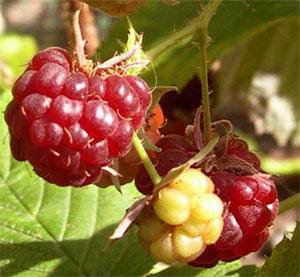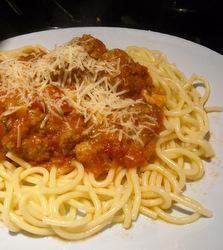Raspberry gin recipe
Posted by Fiona Nevile in Liqueurs | 246 comments
Autumn raspberries are a late fruiting variety with great flavour
This recipe can also be used for blackberry gin and vodka
Our autumn fruiting raspberries are late, but they’re finally here. Just a few of them. Succulent and tempting and the promise of more to follow. If you grow autumn fruiting raspberries you might like to have a go at making this delicious raspberry gin. The liqueur is delicate yet has a fresh raspberry bite that makes a change from the raunchiness of sloe gin. (This is a fresh review. I nipped out to the barn this evening to try some of our July 2006 vintage and it was superb. Fragrant and tasty). At it’s best, raspberry gin totally overshadows sloe gin. We had a tasting of a wide selection of our fruit gin at a dinner party, a few months ago. The clear winner was the raspberry gin.
You can make raspberry vodka using the same method detailed below for gin with similar ingredients, just a little more sugar. We’ve tried both and think that the gin wins hands down. Both are quite drinkable in three months so would be ready for Christmas. I love a dash of this in a fresh fruit salad.We had to buy the raspberries for our gin this summer but the end result will be well worth the outlay. In July we feasted off our early raspberries. We guzzled large bowls of them, sprinkled with castor sugar and had heated discussions as to how to use the rest of the fruit. Unfortunately, I had not secured the netting tightly enough and when I went out with my trug a couple of days later the canes were bare. Raspberries are my favourite fruit and raspberry gin is the biz. It always puts people in the best of moods. People have said the most complimentary things about us after a glass or three of our raspberry gin.
Tips and tricks for making fruit infused gin/vodka:
- If you are using the original gin bottles and you find that you don’t have quite enough gin to fill each one to the neck, don’t worry. We often do the final fill up the next day when we have got more gin.
- Make notes on a label of your fruit/gin/sugar ratio and stick it onto the bottle(s) so that you have a record, if you make a particularly good batch. The best labels are made from decorator’s masking tape as these can be peeled off and passed from bottle to bottle. We also note our responses at the grog matures. Yucky after sixth months can be to die for in a year (you will probably not remember without notes). Notes seem boring when you are making the grog. But they are so worthwhile when you start again the next year. It won’t be long before you will get a feel of what works well for your taste (and the notes will come into their own).
- Make more than you need the first year. So you can compare different vintages. This liqueur does improve over time.
- Some people drain the grog through muslin after a couple of months, to clarify the liqueur and bottle. We don’t bother as one old soak tipped that, once the gin is drunk, you can pour medium sherry on the fruit and start all over again! The latter is devilish and drinkable within three months.
- Keep your fruit gin away from the light as this will maintain the colour. Unless the bottle is dark green or brown. If you are stuck with clear bottles, wrap them in brown paper to keep out the light.
- Every couple of months take a tiny sip. At this time a add sugar if it tastes too sharp.
- If you want to make your own labels check out the post for 26 October 2006 to see how we make our labels.
| Raspberry gin recipe |
- Recipe for raspberry gin:
- 300g of raspberries
- 330g of white granulated sugar
- 1.5 litres (or more) of medium quality gin
- Steriiised 2 litre Le Parfait jar or 2 or 3 (70 cl) washed and sterilised gin bottles
- Wash raspberries and discard any bruised fruit. Place rasberries in either a large 2 litre Kilner/Le Parfait jar or divide the raspberries between 2 or 3 (70 cl) saved gin bottles.
- Using a funnel, add the sugar (divide the amounts if using several bottles) and top up with gin to the rim.
- Shake every day until the sugar is dissolved and then store in a cool, dark place until you can resist it no longer (leave for at least three months, we usually let it mature for a year).
- If you are making blackberry gin remove the fruit after 3 months (pour through muslin) to stop the woody taste developing and mature for at least a year.
Leave a reply






Thanks to Fiona and to all of you for this invaluable info, and for inspiring me to make my own. I started last autumn with sloe vodka (OK but probably needed longer to mature than I gave it) and damson gin (an absolute revelation!). This season I’ve recently begun a litre each of cherry vodka, apricot brandy (experimentally adding to the brandy a small stick of cinnamon and some of the pitted kernels from the apricots) and now some raspberry gin, but using rather more raspberries – 400 gm – and less sugar (2oz to 70cl gin), as I’m used to the northern/eastern European style of schnapps. I’ve managed to get about a kilo of the final damsons of the season,so that’ll be one bottle vodka and one bottle gin. This time I might initially cut down the sugar still further, say to an ounce or even half an ounce per litre container – more could always be added at a later stage.
Hi,
I must have had a lucky escape regarding air space in my jars. Mine were only half full, but I used those bungs with airlocks. Would that have stopped them exploding? Airlocks should have a small amount of water in them, I suppose to bubble the gas through, but mine evaporated. Nothing untoward happened and it all tastes lovely. I can only guess the air escaped through the hole in the bung, and up through the airlock. Really glad they didn’t explode though. I had ten five litre demi-johns under the stairs!
Hi there, I about attempt Blackberry Gin or Vodka (still not quite decided) unfortunately the only Kilner Jar i have is quite large – 2100ml/ 4 1/2 lb. Do you think this will be ok? Was just concerned that the large amount of air space in the jar might be a problem…
Hi Nellaxela
You want to avoid airspace at all costs. If you used your big jar it would cast a bomb to fill up! I usually use old vodka or gin bottles or even screw topped wine bottles at a pinch.
hi, after some very successful cherry brandy last year i’m wondering if anyone could suggest a recipe for rhubarb rum or other rhubarb liqueur.
Hi Jude
I’d follow the outline for damson gin for the fruit to sugar ratio
Well, I left mine in for a long while, more than nine months, and it was longer than I intended to be honest. The flavour is sublime. But I understand why the advice is to steep for less time. You don’t want the fruit to spoil, potentially ruining the alcohol. And make sure your bungs are nice and airtight, whether you’re using airlocks or not.
I love gin and I love raspberries – sounds like a marriage made in heaven so have made 8 litres….
Just a little confused the hints at the top say you can leave the raspberries in until you have drunk it and then top up with sherry, but elsewhere it says you need to strain after 3 months. I love the first idea, so is it ok never to take the raspberries out?
Hi, I think I left the sloes in too long (nine months) and no I didn’t prick them. Maybe tasting as you go along is important too. I’m going sloe picking with an experienced sloe gin maker this year so maybe I’ll pick up some tips. Blackberry brandy…sounds good. Just made plum brandy today. May have to start shopping at different supermarkets. It gets embarrassing.
It’s a pity your sloe gin was a failure, Seahorse. Did you prick the sloes? It really helps with the flavour. My recipe is a third of sloes, a third sugar and top up with gin. Shake every few days until sugar has dissolved and leave for at least three months. The sloes should really be decanted at six months if you can remember to, as I think this gives the best flavour. If you can bear to leave sloe gin for more than a year, it will get stronger and acquire a tawny colour. Blackberry brandy is great too – you should be in time to catch those!
Thanks for the reassurance. It’s unknown territory for me but I’ve loved every minute of my liquer making endeavours and am now sizing up what to make this year. So far, plum brandy, damson gin, sloe gin. Am probably too late for currants and raspberries. But lots of fun and v yummy results
Hi, Seahorse
I wouldn’t think you would have a problem, after all, you will strain the gin before you bottle it. Just make sure you don’t scrape any of the dried product from the sides of the demijohn.
I see I have only one bottle of damson gin left, so will have to get started on some more.
Miriam